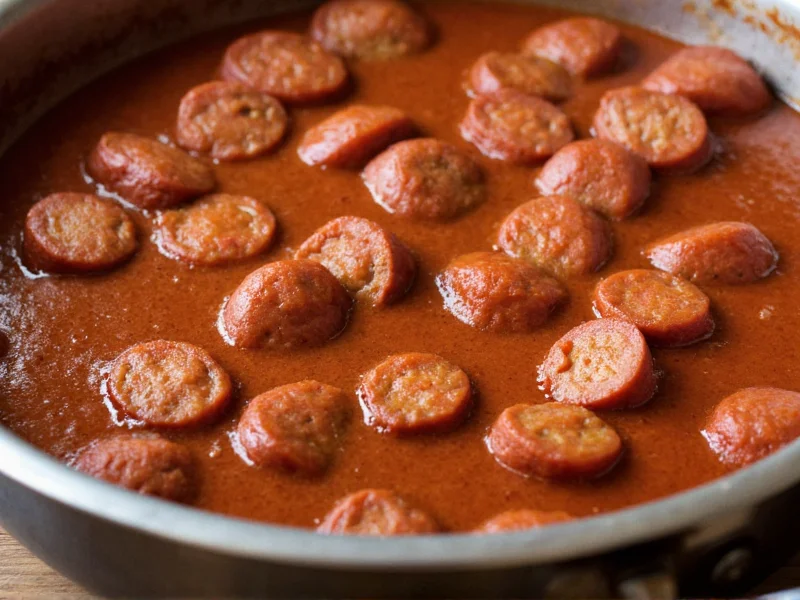For home cooks exploring meatless versions of Southern classics, understanding vegetarian andouille becomes essential. This specialty product bridges the gap between traditional Cajun cuisine and plant-based eating, offering the complex flavor profile that defines dishes like gumbo without animal products. The growing popularity of meat alternatives has led to increasingly sophisticated vegetarian andouille options that capture the essence of this distinctive sausage.
Understanding Traditional Andouille vs. Vegetarian Alternative
Traditional andouille sausage originates from France but evolved into its current form in Louisiana. Made with coarsely chopped pork, garlic, pepper, and other spices, it undergoes double smoking to develop its characteristic flavor. Authentic Cajun andouille contains no fillers—just meat, fat, and seasonings encased in natural casings.
Vegetarian andouille substitutes emerged as plant-based diets gained popularity, particularly among those seeking to recreate beloved Southern dishes without meat. The challenge lies in replicating andouille's unique combination of smokiness, heat, and complex spice notes using plant ingredients. Modern vegetarian versions achieve remarkable similarity through careful spice blending and innovative plant protein formulations.
Key Ingredients in Quality Vegetarian Andouille
Examining the ingredient list reveals how manufacturers recreate andouille's distinctive profile:
- Plant protein base: Most vegetarian andouille uses textured vegetable protein (TVP), vital wheat gluten (seitan), or mushrooms as the foundation
- Smoke flavoring: Liquid smoke or natural smoke extracts provide the essential smoky dimension
- Spice blend: Paprika, cayenne, garlic powder, onion powder, thyme, and black pepper create the characteristic heat and complexity
- Coloring agents: Natural colorants like beet juice or paprika extract mimic the reddish hue of traditional andouille
- Binding ingredients: Flaxseed, chia seeds, or starches help maintain texture during cooking
When evaluating vegetarian andouille substitutes for gumbo, check for minimal artificial ingredients and a balanced spice profile that doesn't rely solely on excessive heat. The best options develop flavor complexity rather than just delivering upfront spiciness.
| Brand | Primary Protein Source | Key Flavor Components | Best For |
|---|---|---|---|
| The Vegenaise Andouille | Wheat gluten | Liquid smoke, cayenne, garlic | Gumbo, jambalaya |
| Upton's Naturals | Seitan | Paprika, black pepper, thyme | Stews, red beans |
| Field Roast | Grain-based | Smoked paprika, cayenne, garlic | Grilling, skillet dishes |
| Homemade versions | Mushrooms, beans | Chipotle, smoked salt, cayenne | Custom flavor control |
Using Vegetarian Andouille in Classic Recipes
When incorporating vegetarian andouille into traditional recipes, understanding substitution ratios proves crucial. Unlike traditional andouille which renders fat during cooking, plant-based alternatives require different handling:
- For gumbo preparation: Sauté vegetarian andouille in 1-2 tablespoons of oil since it won't release its own fat. Add it later in the cooking process than traditional andouille to prevent texture breakdown.
- Flavor development: Build layers by cooking the vegetarian andouille with the "holy trinity" (onion, celery, bell pepper) to maximize flavor integration.
- Texture considerations: Vegetarian versions may soften more quickly than meat-based andouille, so add them toward the end of cooking for dishes like jambalaya.
Chefs specializing in plant-based Cajun cuisine recommend enhancing vegetarian andouille's flavor by adding a teaspoon of smoked paprika or a few drops of liquid smoke to dishes. This technique helps compensate for any flavor loss during cooking and creates a more authentic taste profile when preparing vegetarian andouille gumbo.
Homemade Vegetarian Andouille Options
For those seeking complete ingredient control, homemade vegetarian andouille offers customization opportunities. A basic recipe framework includes:
- 2 cups vital wheat gluten or 3 cups chopped mushrooms
- 1 cup vegetable broth
- 2 tablespoons nutritional yeast
- 1 tablespoon smoked paprika
- 1 teaspoon cayenne pepper
- 2 teaspoons garlic powder
- 1 teaspoon onion powder
- 1 teaspoon dried thyme
- 1/2 teaspoon black pepper
- 2 tablespoons soy sauce or tamari
- 1 tablespoon liquid smoke
Mix dry ingredients, then combine with wet ingredients to form a dough. Knead briefly, shape into sausage links, and steam for 45 minutes. This approach creates a vegetarian andouille alternative with customizable heat levels and smoke intensity, perfect for those exploring how to make vegetarian andouille from scratch.
Nutritional Comparison and Benefits
Vegetarian andouille typically offers significant nutritional advantages over traditional versions. While pork andouille contains approximately 290 calories and 26 grams of fat per 3-ounce serving, plant-based alternatives average 180 calories and 8 grams of fat for the same portion. The switch eliminates cholesterol entirely while providing dietary fiber absent in meat-based versions.
When selecting vegetarian andouille products, check sodium levels as some brands use salt for preservation and flavor enhancement. Opt for options with less than 500mg sodium per serving when possible, especially for those monitoring sodium intake while enjoying vegetarian andouille in traditional recipes.











 浙公网安备
33010002000092号
浙公网安备
33010002000092号 浙B2-20120091-4
浙B2-20120091-4